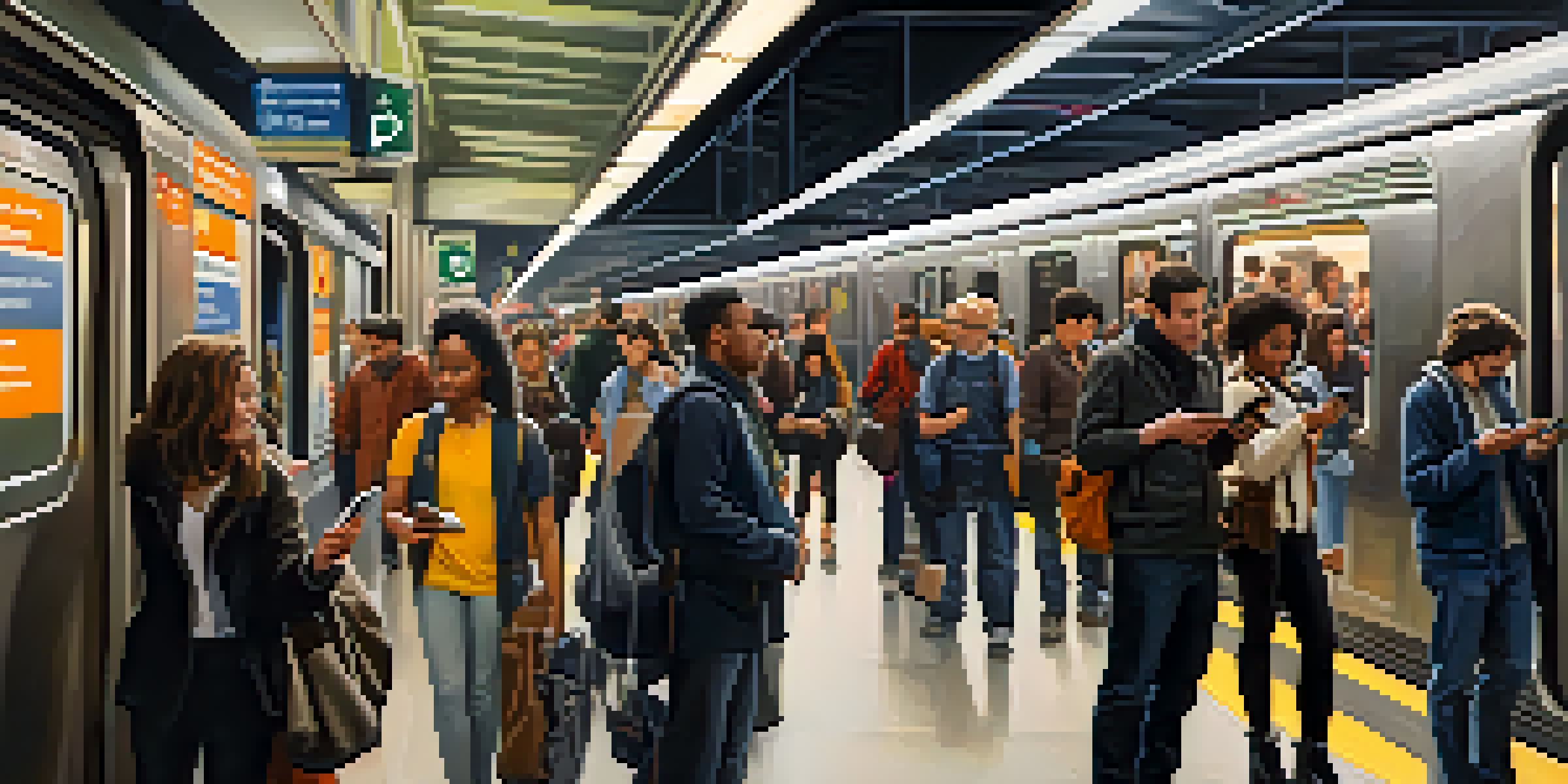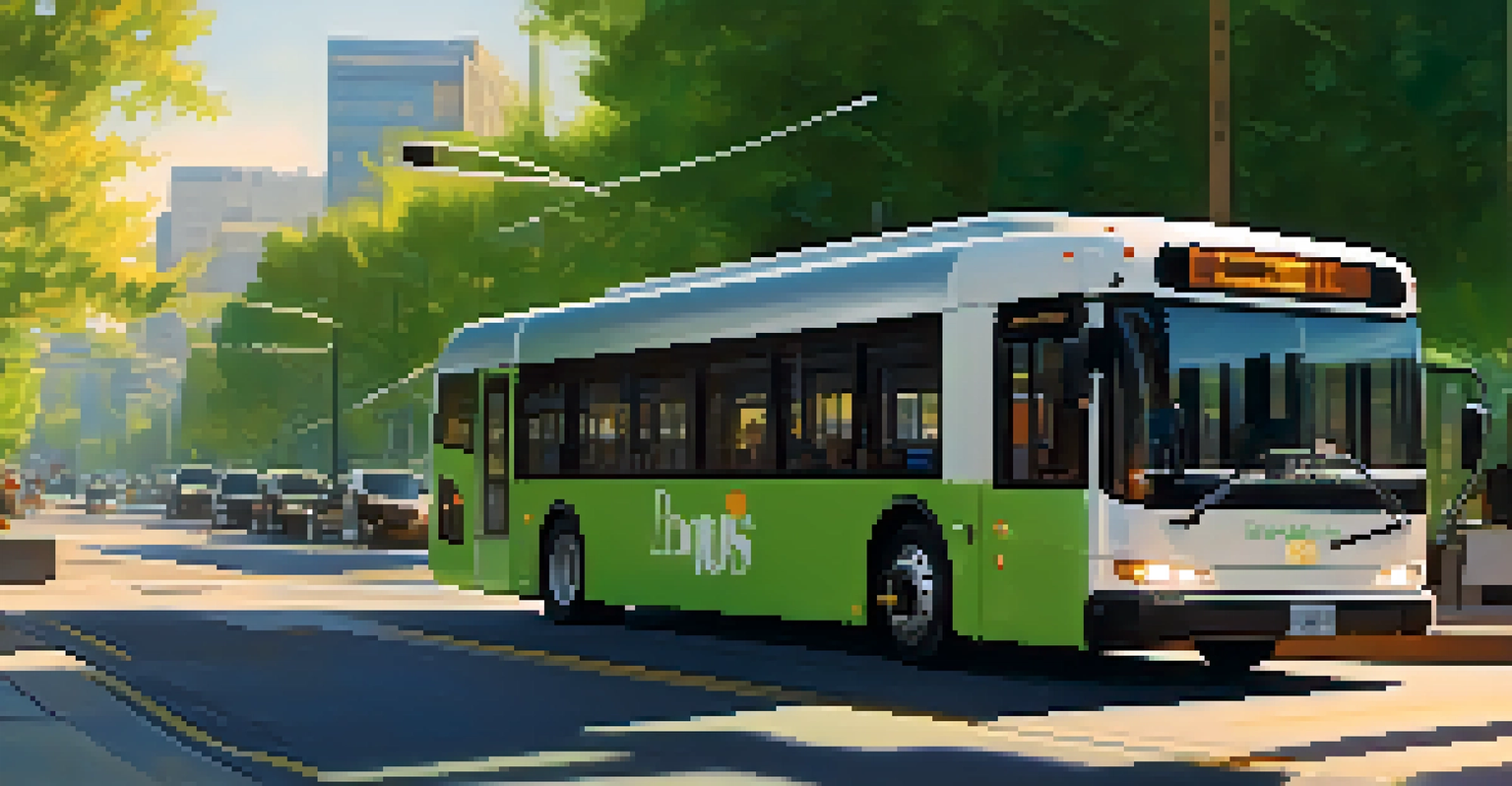The Impact of Technology on NYC's Public Transportation System

Understanding the Role of Technology in Public Transit
Technology has become a pivotal element in reshaping public transportation, particularly in bustling cities like New York. From real-time tracking apps to automated ticketing systems, these advancements aim to enhance the commuter experience. Imagine waiting at a bus stop and knowing exactly when your ride will arrive—this is now a reality thanks to technology. These innovations not only improve convenience but also encourage more people to utilize public transport.
Technology is best when it brings people together.
Moreover, technology streamlines operations, making it easier for transit authorities to manage schedules and resources efficiently. For instance, data analytics helps in predicting peak hours, allowing for better allocation of buses and trains. This kind of proactive management can significantly reduce overcrowding, making public transit a more appealing option for everyday commuters.
Related Resource
Ultimately, the integration of technology into public transportation is about creating a seamless travel experience. As New Yorkers embrace these tech-driven changes, the hope is to foster a culture where public transit is not just a necessity but a preferred choice.
Mobile Apps: Revolutionizing Commuter Experience
Mobile applications have revolutionized how New Yorkers navigate their public transportation options. With apps like Citymapper and MTA's own offerings, commuters can plan their journeys with ease, accessing real-time information at their fingertips. These tools provide route suggestions, transit schedules, and even alerts about delays, making the travel process much smoother.

For instance, if a subway line is experiencing delays, commuters can instantly receive alerts and reroute their journey. This empowerment through information helps reduce frustration and uncertainty. Imagine being able to adapt your travel plans on the fly; this flexibility is becoming a hallmark of modern commuting.
Tech Enhances Public Transit Experience
Advancements like real-time tracking and mobile apps improve convenience and reduce commuter frustration.
Moreover, the use of mobile payment systems allows riders to pay for their fares seamlessly, eliminating the need for cash or physical tickets. This not only speeds up boarding times but also enhances the overall efficiency of the transit system. As technology continues to evolve, so too does the potential for even more innovative features that could further enhance user experience.
Contactless Payments: A New Era of Convenience
The introduction of contactless payment systems has marked a significant shift in how riders pay for their public transportation in NYC. With the ability to tap a credit card or mobile device at turnstiles, commuters no longer need to worry about carrying cash or purchasing MetroCards. This simplicity encourages more people to opt for public transit, knowing they can pay quickly and easily.
The future belongs to those who believe in the beauty of their dreams.
Additionally, contactless payments minimize physical contact, which became particularly important during the COVID-19 pandemic. By reducing the need for cash transactions, the system not only speeds up the boarding process but also promotes hygiene and safety. It's a classic example of how technology can adapt to meet the needs of the times.
Related Resource
As contactless payments become more widespread, there's potential for even greater integration with other services. For instance, riders could use the same payment method for multiple forms of transportation, such as buses, subways, and even bike rentals, creating a more unified transit experience.
Real-Time Tracking: Keeping Commuters Informed
Real-time tracking has become a game changer for NYC's public transportation system. Commuters can now access live updates about their buses and trains, reducing the anxiety of waiting. Imagine standing on the platform, watching the countdown clock tick down, and knowing exactly when your train will arrive—it’s all thanks to advancements in tracking technology.
This transparency not only enhances the commuter experience but also builds trust in the public transit system. When people can see that their trains or buses are running on time, they're more likely to rely on these services regularly. This shift in behavior can lead to increased ridership and, ultimately, a more sustainable transportation model.
Contactless Payments Boost Convenience
The shift to contactless payment systems simplifies fare transactions, promoting hygiene and efficiency.
Moreover, real-time tracking data is valuable for transit agencies, allowing them to identify patterns and make informed decisions about service adjustments. By continuously analyzing this data, they can optimize routes and schedules to better serve the needs of the community.
Big Data: Improving Operational Efficiency
Big data has emerged as a vital tool for enhancing the operational efficiency of NYC's public transportation system. By collecting and analyzing vast amounts of data, transit authorities can gain insights into commuter behavior, peak travel times, and bottlenecks in the system. This information is crucial for making informed decisions about resource allocation and service improvements.
For example, if data reveals that certain bus routes are consistently overcrowded during rush hour, adjustments can be made to increase frequency or add additional buses. This proactive approach not only improves the commuter experience but also ensures that resources are used effectively.
Related Resource
Additionally, big data can help in predictive maintenance, where potential issues with vehicles or infrastructure can be identified before they lead to service disruptions. By embracing these technologies, NYC's transit system can enhance reliability, ultimately making it a more attractive option for all residents.
Sustainability and Technology: A Greener Future
As cities around the world grapple with the challenges of climate change, NYC's public transportation system is increasingly turning to technology for sustainable solutions. Electric buses, smart traffic management systems, and energy-efficient infrastructure are just a few examples of how technology is promoting a greener future. These innovations not only reduce emissions but also enhance the overall efficiency of public transport.
For instance, electric buses offer a quieter, cleaner alternative to traditional diesel vehicles, contributing to improved air quality in the city. Furthermore, smart traffic management can optimize traffic flow, reducing congestion and the associated environmental impacts. This synergy between technology and sustainability is essential for creating a more livable urban environment.
Big Data for Operational Efficiency
Analyzing big data helps transit authorities optimize services and address overcrowding effectively.
By investing in these advancements, NYC's transit system positions itself as a leader in sustainable urban transportation. As more cities look to reduce their carbon footprints, the lessons learned from NYC’s technological innovations could serve as a blueprint for others.
The Future of Public Transportation in NYC
Looking ahead, the future of public transportation in NYC is bright, thanks to ongoing technological advancements. Innovations such as autonomous vehicles and AI-driven scheduling promise to transform how residents move throughout the city. Imagine a future where self-driving shuttles navigate the streets, providing on-demand rides to commuters—this could soon be a reality.
Moreover, as technology continues to evolve, we can expect even more integrated and user-friendly systems. The goal is to create a cohesive urban mobility experience, where all modes of transportation work seamlessly together. This interconnectedness not only enhances convenience but also encourages the use of public transit over personal vehicles, leading to reduced traffic congestion.

Ultimately, the impact of technology on NYC's public transportation system is a testament to the city's adaptability and forward-thinking approach. As these changes unfold, residents can look forward to a more efficient, sustainable, and enjoyable commuting experience.